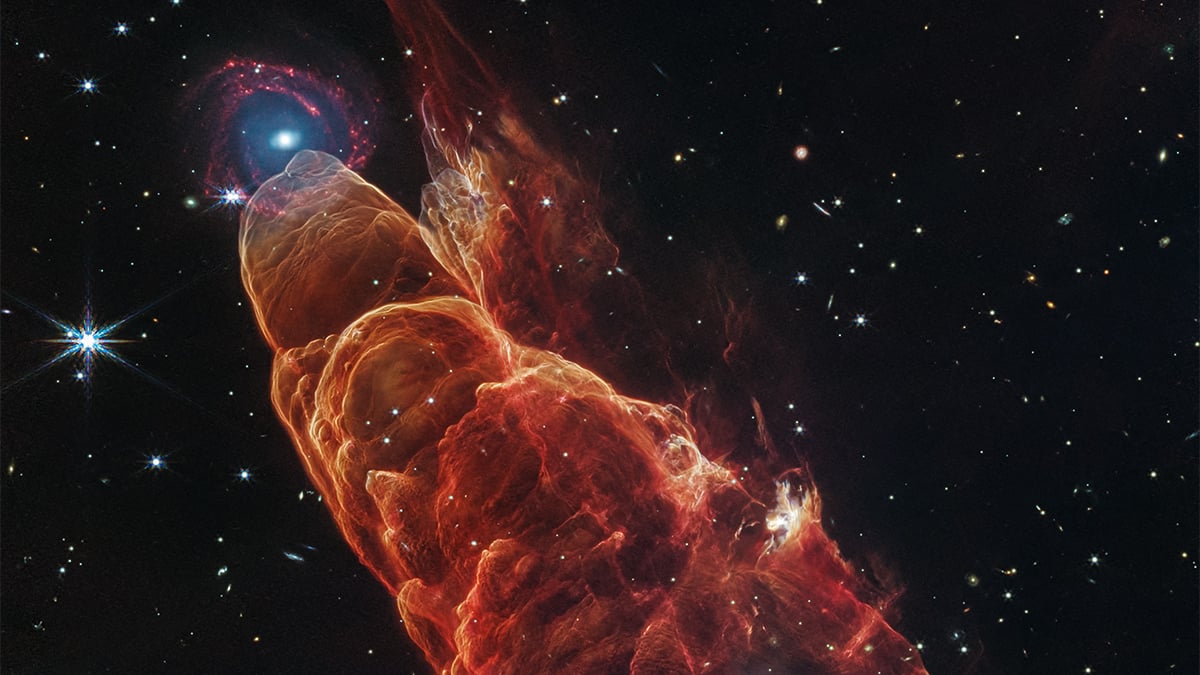
The James Webb Space Telescope (JWST) has recently unveiled a captivating image of Herbig-Haro 49/50 (HH 49/50), offering an unprecedented glimpse into the intricate processes of star formation. This high-resolution observation, utilizing JWST’s Near-Infrared Camera (NIRCam) and Mid-Infrared Instrument (MIRI), provides detailed insights into the dynamic interactions between protostellar jets and their surrounding environments.
Understanding Herbig-Haro Objects
Herbig-Haro (HH) objects are luminous regions that form when narrow jets of ionized gas ejected by newborn stars collide with nearby clouds of gas and dust at high velocities, typically several hundred kilometers per second. These interactions produce shock waves that heat the surrounding material, causing it to glow and creating the distinctive nebulous structures characteristic of HH objects. They are commonly found in star-forming regions and serve as critical laboratories for studying the early stages of stellar evolution.
Detailed Observations of HH 49/50
Located approximately 630 light-years away in the Chamaeleon I cloud complex—a prominent star-forming region within our Milky Way galaxy—HH 49/50 vividly displays the interactions between protostellar outflows and the interstellar medium. The recent JWST observations reveal intricate features of the outflow, represented in reddish-orange hues, offering detailed clues about how young stars form and how their jet activity affects their surroundings.
The Webb team writes:
Like the water wake generated by a speeding boat, the arcs in this image are created by the fast-moving jet slamming into surrounding dust and gas.
The high-resolution imaging capabilities of JWST have allowed astronomers to observe fine details of the shocked regions within HH 49/50. The bow shocks exhibit arc-like structures as the fast-moving jet from the young star collides with the surrounding dust and gas. These observations provide valuable insights into the mechanisms by which protostellar jets influence their environment, contributing to our understanding of star formation processes.
Previous observation of this object by now retired Spitzer telescope did not reveal details of the fuzzy object at the top. JWST’s higher resolution has allowed scientists to reveal the object as a distant spiral galaxy. And it is a “lucky alignment”.
The galaxy that appears by happenstance at the tip of HH 49/50 is a much more distant, face-on spiral galaxy. It has a prominent central bulge represented in blue that shows the location of older stars. The bulge also shows hints of “side lobes” suggesting that this could be a barred-spiral galaxy. Reddish clumps within the spiral arms show the locations of warm dust and groups of forming stars. [NASA]
The Role of JWST’s Instruments
The observations of HH 49/50 were conducted using JWST’s NIRCam and MIRI instruments.
- NIRCam (Near-Infrared Camera): Captures light in the near-infrared spectrum, allowing astronomers to penetrate dense regions of gas and dust to observe the processes occurring within.
- MIRI (Mid-Infrared Instrument): Operates in the mid-infrared range, enabling the detection of cooler materials and providing complementary data to NIRCam’s observations.
Together, these instruments offer a comprehensive view of HH 49/50, revealing the complex interplay between protostellar jets and their environments.

Scientific Implications and Future Research
The detailed observations of HH 49/50 have significant implications for our understanding of star formation. By studying the interactions between protostellar jets and the interstellar medium, astronomers can gain insights into the processes that govern the birth and early evolution of stars. Furthermore, these observations contribute to our knowledge of how stellar feedback influences the surrounding environment, shaping the structure and dynamics of star-forming regions.
Future research will focus on analyzing the data collected by JWST to further investigate the properties of HH 49/50 and similar objects. By combining observations from different instruments and wavelengths, astronomers aim to develop a more comprehensive understanding of the complex processes involved in star formation and the role of protostellar jets in shaping the interstellar medium.
For a visual representation of these observations, check out this related video:

The recent JWST observations of HH 49/50 provide a remarkable glimpse into the dynamic interactions between young stars and their environments. These findings enhance our understanding of the early stages of stellar evolution and underscore the capabilities of JWST in advancing our knowledge of the universe.
Clear skies!




